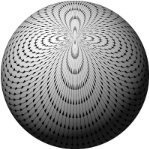-
Posts
1007 -
Joined
-
Last visited
cladking's Achievements

Organism (8/13)
-108
Reputation
-
I should understand this study and its results better than I do. I didn't realize when I posted it that it is essentially the same study done a couple years back that I didn't post here because I found the results to be suspicious, but more importantly, because the results neither support Egyptological theory nor mine. Indeed, the passages can be taken as internal ramps better supporting their concepts than mine. I no longer have access to the original so can't compare them but the only change may be that more math is shown. There will be more and more of this sort of testing and remote sensing with ever better equipment, analysis, and expertise whether Egyptology cooperates or not. There are more theoretical means of imaging these that haven't been invented and developed yet. I have little doubt the answers will be forthcoming within a few years.
-
This is simply fascinating; https://www.mdpi.com/2072-4292/14/20/5231 The authors suggest that the function of the pyramid was related to hydraulics. All advancement in the study of the pyramids is now outside Egyptology which still won't release the infrared results from 2015. I have some question about the validity of all these results but I'm quite confident at least some of it is fully legitimate and accurate. I'm still digesting it. (b Interferometric fringes of Khnum-Khufu I seriously doubt we'll understand the pyramids until we give up the notion that its builders were superstitious.
-
Here's another new one; "One indication that it could have been used is that according to Ghoneim these pyramids were "located exactly at the bank of the branch that we found" which could mean that they were "valley temples" which acted like ancient ports." Imagine that! "Valley Temples" were actually valley ports. Next someone will propose the causeways were ramps that delivered stone right to the very bottom of the pyramid! Maybe the "Mortuary Temple" was actually "The Great saw Palace" since the stones mustta been sawed somewhere. Just incredible!! [www.indy100.com]
-
"The study suggests that the larger pyramids of Cheops and Chephren on the Giza plateau resulted from technical progress that began with earlier pyramids. These massive pyramids might have also involved the hydraulic systems hypothesized for the Step Pyramid." https://www.zmescience.com/science/news-science/egypt-pyramid-hydraulic-system/ This is new. It is a small step from saying the first great pyramid employed water in its construction to all great pyramids used water.
-
"Vaterite" is a metastable form of calcium carbonate often associated with CO2 geysers. This new information about the presence of copper many centuries earlier than pyramid construction simply dovetails nicely with my hypotheses and predictions. Not only were the great pyramids built at least three centuries earlier than is believed but the water source that brought the copper existed many centuries earlier still. I've been trying for years to get them to look for copper to corroborate my predictions and it has finally happened. It is quite apparent the science will fall in line ever more quickly to support this new paradigm. I used to call the old interpretations a "teflon paradigm" because no facts would adhere to it but every fact seems to fall right into place when we say 'they mustta used funiculars'. Egyptology still refuses to release the results of the 2015 infrared study for which I spent years campaigning to have done. The little that was released confirmed my predictions of a passage under the chevrons and a hot spot on the east side at ground level. I have no doubt several other of my predictions will be borne out in the massive amount of data that comprises this study.
-
It's a shame there are no good pictures yet related to this copper "pollution". There is a very interesting blue stone atop the pyramid but several months of investigation has yet to reveal any data about it. It has been exposed to the elements since at least the 13th century. Whatever caused this stone to be blue is deep into it since graffiti carved in it shows blue below. This picture is the one that shows stones came up the south side (bottom of photo) and then were distributed right to left starting on the opposite side. This implies the stones came straight up the side.
-
Much of any copper hydroxide that didn't survive on the north side through chemical decomposition as well as any copper sulfate dissolved in the water would be deposited as copper oxides in the harbor below. This would spike after construction of the causeway and drilling of the well that occurred centuries before pyramid construction began around 2850 BC. This has been found. https://www.ancientportsantiques.com/wp-content/uploads/Documents/PLACES/Egypt-Libya/Gizeh-Younes2024.pdf It is found in conjunction with arsenic which is rarely found in ancient Egyptian bronze artefacts (most are copper). Realgar and tennantite which contain arsenic is often found in conjunction with low temperature low temperature hydrothermal veins and geyser deposits. It is also found with sulfur which I believe also came up with the water because the builders apparently said the water had a powerfully bad odor. The collection point of the samples was a few hundred feet east of the valley port, called the Valley Temple by Egyptologists.
-
...As Kuhn said; "paradigms change".
-
I'm certainly not suggesting any theory be tossed out or tweaked because of one anomalous result that isn't or might not be understood.
-
I agree, except it is apparent that the primary problem is in the extrapolation of experimental results that Kuhn called a "paradigm". We reduce reality to experiment using definitions and axioms in the context of existing understanding and then tend to forget that ultimately experimental results are defined by these and the specific design. Obviously I agree except that I believe that in the long run most of our current understandings will fall by the wayside.
-
Yes. It is for this reason that experiment is critical in establishing theory. I believe humans by nature reason in circles and always come back to our assumptions unless experiment intercedes. Bias introduced through hypothesis formation is not direct but most people most of the time will come up with hypotheses that support prevailing paradigms. I don't think it is possible for our species to be objective because we preferentially see our models and beliefs to reality. We don't see a "basketball" we see Michael Jordan. Objects we see often turn out to be something else entirely either on further inspection or a simple change of models or beliefs. It's possible thoughts can be discerned some day with sufficiently sensitive instruments. A more interesting question might be what leads us on some specific train of thought. In the human thirst for knowledge, understanding, and creation nothing will get in our way whether it's the status quo, beliefs, or existing methodology. Everything in the way will eventually be bulldozed aside so long as one of us survives. Yes, I believe there will be limitations on science and I further believe we've been at a major obstacle for a century now. But we shall overcome.
-
Yes, I agree that the principle problem with objectivity is in paradigms but there is also some problem with experiment itself because we still see what we expect and experiment is only relevant within the definitions and axioms underlying it and proper interpretation in light of its parameters. There is incidentally some bias introduced by the formation of testable hypotheses. We can't test what we don't first hypothesize. Science, reality, is sought to be understood to better control our lives and make better predictions. If science is lacking in any way whatsoever it behooves us all to identify and correct it. Anything else is anti-science and anti-life. If science can be improved in any way it must be improved.
-
There have been a couple new developments very highly supportive of my hypotheses; First is that Egyptology now recognizes something I've known for years; All of the so called "Valley Temples" which each great pyramid has lines up along the edge of an ancient arm of the Nile River. https://researchers.mq.edu.au/en/publications/the-discovery-of-the-ahramat-nile-branch-a-hidden-ancient-waterwa This is of critical importance since it describes the routes of casing stones and supplies up a long "ramp" straight to the very bottom of the pyramid. Since it is the bottom it strongly suggests there were no ramps to take stones up the side of the structure. Instead the "valley temple" is in actuality a "port" and the "Mortuary Temple" is actually a mason's shop that the builders called "The Great Saw Palace" because it made some half a million cuts through Tura Limestone using pendulum saws powered by water. There was no "Holy Walkway" down to the port but just a sloped surface they called "The Ladder of Set" and we call "The Causeway" and was used as a funicular run. Second and perhaps more importantly is that a team of interdisciplinary scientists have found extensive evidence for the use of hydraulics to build Djoser's Pyramid. Remarkably they even agree with me that the excavations around the enclosure was full of water and that a river flowed through what Egyptologists call the "Hypostyle Hall" on it's southern side! https://journals.plos.org/plosone/article?id=10.1371/journal.pone.0306690 Furthermore they go on to suggest that water was removed in the same way from the catchment as I propose and is evident at the Great Pyramid: "The excavations performed on the eastern wall of the Gisr el-Mudir highlighted a lower structural quality [45]. Its shape is similar to that of the western wall, with a distinctive parabolic profile (Fig 6, line C-D). Furthermore, it discloses two topographical singularities: first, its overall altitude is a few meters lower than the western wall (Fig 7A). Then, in the southern part of the eastern wall, a geophysics anomaly (G2 in Figs 4B and Fig 6) was found to be a series of massive, roughly cut, ‘L’-shaped megaliths [45, 66]. Before our study, these megaliths were thought to possibly be the remains of a monumental gateway–due to their similarities with the Djoser’s complex enclosure’s entrance–but their purpose was not specified [66]. According to our analysis, these megaliths could be the side elements of the water outlets, possibly slit openings [76] that were likely closed off by wood beams but could be opened to drain the basin. They are consistently found near a trench that is 2.2 m deep [45], which we believe is possibly the canal that guided outflowing water. In a nutshell, the eastern wall likely acted as a second check dam to the Abusir flows."
-
They do a superb job of providing an overview of almost everything. But they do a poor job of being consistently factually correct and differentiating fact and opinion. I think of wiki as the ideal place to go for experts who don't know much about a subject outside their own field.
-
Actually the Great Pyramid is just the tip of an obelisk.







